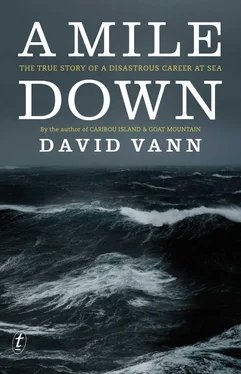“I already give him something,” Seref said. “It is done. Don’t think about it. Come.” He gestured toward the other end of the mast. “We have to decide something.”
I looked at the man again and nodded to him. “I’m sorry,” I said. I felt like a monster. He had a face that didn’t show anything to me, no remorse or pain or resentment or even recognition. If anything, he seemed impatient for me to leave so he could get back to work. I had no idea what to think or feel or do, so I turned and followed Seref.
The top of the main mast had a stainless steel cap with a lot of wires and attachments.
“We have to decide this,” Seref said. “You said you want battery cable to here, and a post for the lightning?”
“That’s right,” I said. “And a bonding plate below on one of the keels, and the grounds run to the hull. That way the lightning has a quick path to the water.”
“Okay,” he said. “You like your masts?”
“Well, they’re not caulking the screws. And they’re using two pieces of track, not one continuous piece, so every time I pull the sail down, it will get caught where the track is being joined. And the lower spreaders are supposed to have twin notches for the wires, not just one notch, and the ends of all the spreaders need boots. And the masts themselves are very heavy.”
Seref smiled at me, then grabbed both of my shoulders. “David. I will say this to you. This boat is not finished. When it is finished, I will hand you the keys and everything will be done. Everything. Okay?” He let go of one of my shoulders and held an imaginary set of keys in the air.
I didn’t believe him, but what could I say? I knew now I should have been working with a shipyard to finish the boat, not with the owner of a tour company, because at least some and perhaps all of the mistakes Seref was making were from lack of experience, not by design. But the summer before, when I had first bought the hull, I had believed, and Seref had encouraged me to believe, that he possessed the necessary experience and expertise and could finish the boat for less without the shipyard. Now he was doing his best, but his best might not be good enough, and it was too late for me to go with anyone else. I had given all of my money to Seref.
Seref led me up the ladder to see more. The deck was newly sanded, the space enormous, magnificent for sailing through the Mediterranean and Caribbean. The pilothouse was nearly finished. The dash under the forward windows, in mahogany strips caulked like decking, was varnished a deep, gleaming auburn.
“This looks great,” I said, and Seref smiled and beckoned me below, down the companionway.
Below was a different story. I felt sick seeing it. The main salon and galley were bare steel. No deck, no walls, no ceiling, no galley partition or settee or desk. He hadn’t done anything in here.
But Seref had already gone down the next set of stairs to the aft cabins, so I followed. Here, too, the floor was only steel, the ceilings bare with wires hanging. The walls for the hallway were tongue-and-groove mahogany, and the frames for the doors to the six aft staterooms had been fitted, but the wall going aft on the starboard side had a large bend to it. I was overwhelmed by disappointment and fear and could latch onto only this one detail. “This wall,” I told Seref. “It isn’t straight.”
“It will be straightened,” Seref said.
“When? I run a charter in six weeks. The wall has already been set. They’re building the room onto it now.”
“David. I said I would fix it. Now look at one of your staterooms.”
I looked at one, and it was not what he had promised. It was solid mahogany, tongue-and-groove, as requested. But the strips of mahogany were greatly uneven. As I looked along any wall, I could see a strip of mahogany sticking out here and there. And it was all too late. The boat would have these imperfections until its final day. It had already gone far over budget, it still required more equipment and construction, and it was being built full of flaws.
I saw, too, that the insulation they were using behind the walls was only Styrofoam. They had just broken pieces of Styrofoam and stuck them in against the steel, then nailed the plywood over it. The corrosion would be a nightmare. In April, when I had visited for three days, I had asked for spray foam over all the steel before any wood was placed. That way the hull would last, would not rust from the inside.
“What about the spray foam?” I asked. “Where is the spray foam?”
“Yes, we need to talk about this. Now tell me what it is exactly that you want.”
“But we’ve already talked about it, many times. And now it’s too late. You can’t spray anymore. You’ve already built over the steel.” I turned away from Seref into one of the other rooms. I was not proud of myself, of how I was complaining, but nothing was right, and it was all too late, and what does one do?
I looked in one of the heads and saw that they were not finished either. Toilets still not installed, no sinks, no tile on the floor, walls unpainted. Eight of these bathrooms, one for each stateroom, and nothing had been done yet with any of them.
“We must talk about the bathrooms,” Seref said. “What type of sinks you want. We will have to buy these. I have an idea, a good type of sink.”
“Where are the toilets?” I asked. “The nine toilets that I bought and sent clear back in December, half a year ago, $750 each, so they could be installed right away?”
“David, really you push too much. They are in the back rooms, the same as when you visited in April. We are waiting to decide on the floors first.” He was looking out into the hallway. Many of the men were listening to us with one ear while they worked, some of them able to understand English, and I knew this bothered him.
“Well decide it now. Tile. Just put in some tile. White or green or whatever you can find. I have to run a charter in six weeks. You have to start deciding and working faster. You will not finish at this pace.”
Seref put one hand through his hair and exhaled, then he walked out of the room. I was pissing him off, which was fine with me. It seemed necessary at this point.
I walked back through the bare main salon and down a hatch in the galley to the engine room. I found Ecrem in there with a shop light. I had met Ecrem in April, a small guy who looked almost English but spoke no English. He worked for very little money, Seref said, and he was doing most of the mechanical and plumbing work. We both smiled and nodded and said hello in Turkish. That was all we could do, so he went back to work, welding a platform for a discharge pump, sending white-blue light in jagged shapes along the steel walls. I could see myself outlined in these flashes like a burglar as I walked back between the engines.
I pulled out my flashlight. Beautiful new diesels painted a dull blue. I traced their fuel lines and exhaust systems and found problems.
Seref called for me and I yelled I was in the engine room. I was going to tell him about the engines, but he came down the ladder with the electrician, a formal old man I had met in April who was reputed to be the best in Bodrum for a boat’s electrical systems. He and Seref showed me the fuse box for the twenty-four-volt system, and I asked how the engine batteries tied in. They looked puzzled and we went up to the electrical panels, which had been custom made in the United States and shipped to Turkey. Behind the panels were the big switches, and it was the cables to these I started tracing. They weren’t run the way I had asked.
“These switches here,” I showed both men, “in the emergency position, need to connect to the house banks.”
The old man waved his finger back and forth, telling me no. He clucked with his tongue, as if I were an ignorant child. Then he talked to Seref in Turkish.
Читать дальше












